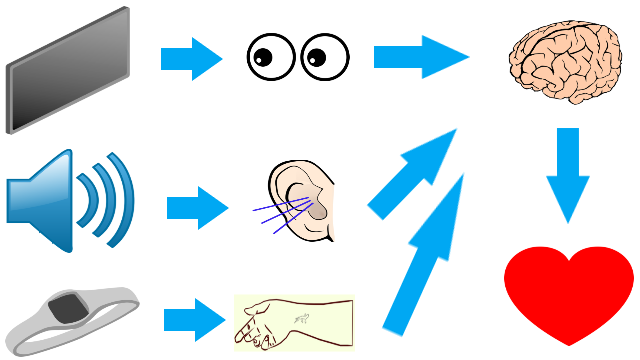My opinion on affective media and wearables paper when I was a young student

This is one of my Masters assignment from Media Information Processing Course which has never been published anywhere and I, as the author and copyright holder, license this assignment customized CC-BY-SA where anyone can share, copy, republish, and sell on condition to state my name as the author and notify that the original and open version available here.
My opinion and thoughts on Prof. Rosalind Picard’s paper on, “Affective media and wearables: surprising findings” will be written as following. At first there was a similarity in my lab of human interface where we develop a technology with always keeping in mind that the final receiver is always us “human being”. Also as I’m in the E-learning group, most of the evaluations are based on the users, whether it is their emotion, performance, etc. Prof. Rosalind Picard started a new research field in affective computing. Their research group background is that most technologies were created without putting emotions into consideration. Maybe back then most of them only focuses on cognition side (a person’s ability and processing power) but lacks on emotion side (frustration, stress, etc). Her field of study claims to balance the cognition and emotion on developing technologies.
Even before she started the research group she already suggested that computers need the skills of emotional intelligence for interaction with us “people”. She started by enabling computers to be able to interact with human emotions. Her product can be in form of wearable sensors, audio and video coupled with signal processing, etc. These products are design to be able to sense the physical and the emotional condition of the user. Then they will respond these values, whether to the health condition, stress level, or frustration of the users to ease them, in other words user friendly.
This field needs a collaboration between other fields (lots of them) because it includes many different aspect. The starting is in the psychology of human emotions, one of the oldest research field, that we need to understand human emotions. Up to now, not yet I have heard that a device exist that could straightly identifies the emotion of someone, but instead uses the physical phenomena that is generated by the person, for example the body heat, heart beat, and blood pressure. Thus sensors are necessary in this field to capture these values, since most of these sensors are electronic devices, the field of electronics is necessary. The values should then be converted to readable informations for people. The next step is to make the device understand a person’s emotion. With the data extracted from the user, the device should process it and makes a judgment whether the person is happy, sad, angry, or other emotions. After that the device should react accordingly to these values or give feedbacks, which those in the fields of informatics can do. Once the prototype is finished then we need to think of the design. Should we embed pressure sensors on keyboard and mouse? Should we use webcam to identify the user’s facial expression? Should we embed wearable sensors to the user? We must think of a strategy to apply this without adding discomfort to the user. Once a computer is aware of the person’s condition and emotion, they should interact with the person. In what ways can the computer, device, or a machine respond to a person’s emotion? To answer this question Engineers, Health Physician, even Psychologists needs to collaborate. In the end we strive in to make a technology that is alive and more understanding.
Another topic is using the media to communicate between people. With the advance in technology we can use electronic devices to communicate with others in long distances. We can send informations via text, but it’s still on research when involving emotions in this communication. The media that is currently the closest to face to face communication is video conference. The device will do on our behalf by capturing our voice and image to transmit far away. By hearing and seeing the person we communicate our feelings or emotions. But the feeling of something is missing is still there. For example, can we comfort a sad person through video call the same way as we comfort them when they are there. That’s another reason why the field of affective computing exist today. The media can mediate informations, but it still a question when involving emotions.
Mirrors
- https://www.publish0x.com/fajar-purnama-academics/my-opinion-on-affective-media-and-wearables-paper-when-i-was-xvwjpkj?a=4oeEw0Yb0B&tid=github
- https://0darkking0.blogspot.com/2021/02/my-opinion-on-affective-media-and.html
- https://0fajarpurnama0.medium.com/my-opinion-on-affective-media-and-wearables-paper-when-i-was-a-young-student-4d0a70ccdb1d
- https://0fajarpurnama0.github.io/masters/2020/07/22/opinion-affective-media-wearables
- https://hicc.cs.kumamoto-u.ac.jp/~fajar/masters/opinion-digital-forensic-steps
- https://steemit.com/technology/@fajar.purnama/my-opinion-on-affective-media-and-wearables-paper-when-i-was-a-young-student?r=fajar.purnama
- https://stemgeeks.net/technology/@fajar.purnama/my-opinion-on-affective-media-and-wearables-paper-when-i-was-a-young-student?ref=fajar.purnama
- https://blurtter.com/blurtech/@fajar.purnama/my-opinion-on-affective-media-and-wearables-paper-when-i-was-a-young-student?referral=fajar.purnama
- https://0fajarpurnama0.wixsite.com/0fajarpurnama0/post/my-opinion-on-affective-media-and-wearables-paper-when-i-was-a-young-student
- http://0fajarpurnama0.weebly.com/blog/my-opinion-on-affective-media-and-wearables-paper-when-i-was-a-young-student
- https://0fajarpurnama0.cloudaccess.host/index.php/9-fajar-purnama-academics/211-my-opinion-on-affective-media-and-wearables-paper-when-i-was-a-young-student
- https://read.cash/@FajarPurnama/my-opinion-on-affective-media-and-wearables-paper-when-i-was-a-young-student-e3e1ad7b
- https://www.uptrennd.com/post-detail/my-opinion-on-affective-media-and-wearables-paper-when-i-was-a-young-student~ODY0NTQ5